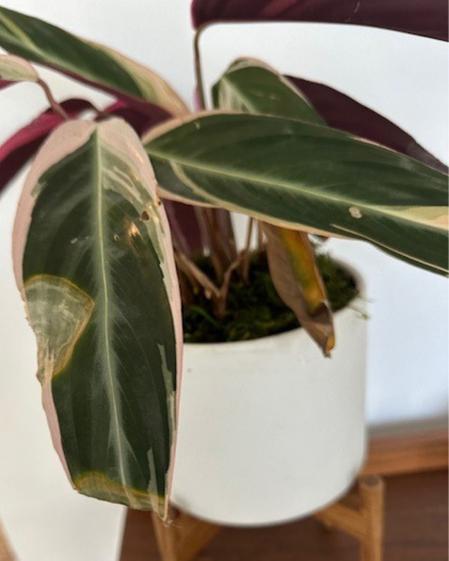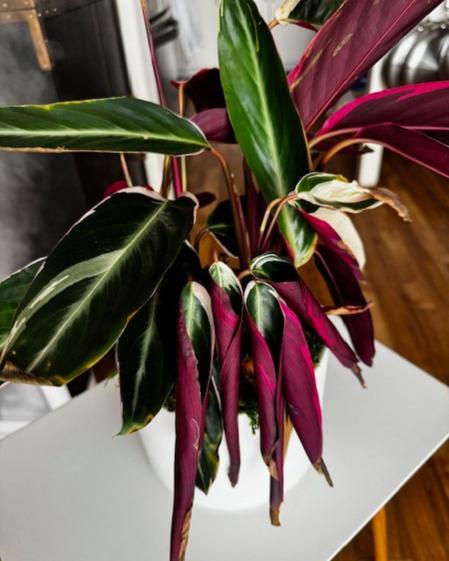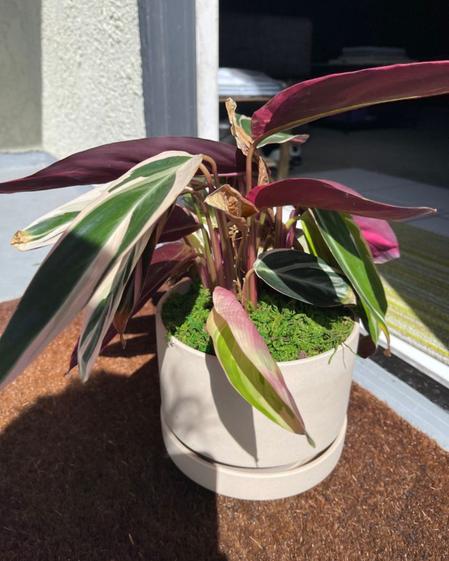{{ this.results.length }} Results
Your search for {{ this.pattern }} didn't return any results.
Stromanthe Triostar Care Guide

A striking member of the prayer plant family, the Stromanthe Triostar (Magenta Triostar or Stromanthe Sanguinea Triostar) dazzles with its vibrant variegated leaves in shades of green, cream, and vivid pink. Its dramatic foliage makes it a true statement plant, but caring for this tropical beauty can take some trial and error. Sensitive to its environment, the Triostar thrives with the right balance of light, humidity, and water. Read on for everything you need to know to keep your Stromanthe Triostar healthy, vibrant, and thriving
Simple Care Instructions for the Stromanthe Triostar
Light Requirements
This plant thrives in bright, indirect light—just like the dappled sunlight of its native rainforest floor. One of its most charming traits is its ability to open and close its leaves in response to changing light levels throughout the day, a behavior known as nyctinasty. Be sure to keep it out of direct sun, especially during peak hours, as its delicate variegated leaves can scorch easily under harsh rays.
Watering Needs
Keep the soil consistently moist but never soggy. The Stromanthe Triostar prefers a regular watering schedule—typically once a week—allowing the top inch of soil to dry out slightly between waterings. Be careful not to let it dry out completely, as the plant is sensitive to drought and may develop crispy brown edges. Use room-temperature, filtered, or distilled water if possible, as this plant can be sensitive to chemicals and salts found in tap water. During the winter months, you can reduce watering slightly as growth slows.
Need help watering? Use a moisture meter to always know the best time to water. Shop our favorite minimalist moisture meter here.
Humidity and Temperature
The Stromanthe Triostar thrives in high humidity and warm, stable temperatures—just like its native tropical habitat. Aim for humidity levels above 50%, though 60–70% is ideal. Dry air can lead to browning leaf edges, so consider using a humidifier, pebble tray, or regular misting to keep moisture levels up, especially during winter or in dry indoor environments.
This plant prefers temperatures between 65–80°F (18–27°C). Keep it away from cold drafts, heating vents, and sudden temperature changes, as it’s sensitive to stress. Avoid exposing it to temperatures below 60°F (15°C), as prolonged cold can damage the leaves and stunt growth.
Soil and Fertilizing
Plant your Stromanthe Triostar in a well-draining, nutrient-rich potting mix that allows for plenty of aeration.
During the growing season (spring and summer), feed your plant with a balanced, diluted liquid fertilizer once a month to support healthy growth and vibrant foliage. Reduce or pause feeding in fall and winter when growth naturally slows. Be careful not to over-fertilize, as this can lead to leaf burn and mineral buildup in the soil.
Common Problems and Troubleshooting Tips
Leaf Curling
Symptoms: Leaves curl inward or fold up, often appearing dry or slightly twisted.
Cause: Most commonly a response to low humidity, underwatering, or sudden temperature changes.
Solution: Leaf curling in a Stromanthe Triostar is a sign your plant is stressed—usually due to dry air or inconsistent watering or not enough watering. Adjust your watering routine and in the case of underwatering, give your plant a good bottom watering/soak so that it can fully hydrate again. If the environment is very dry, consider placing a humidifer near your plant.
Pale Yellow Leaves
Symptoms: Leaves lose their vibrant color and turn a faded or pale yellow.
Cause: Overwatering or poor drainage leading to root stress or rot.
Solution: Pale yellowing leaves are often a sign that your Stromanthe Triostar is receiving too much water or sitting in soggy soil. Check that your pot has proper drainage and that the soil isn’t overly compacted or waterlogged. Allow the top inch of soil to dry out before watering again, and consider switching to a well-aerated mix if drainage is poor. If the problem persists, inspect the roots—if they’re mushy or dark, trim the damaged portions and repot your plant in fresh soil.
Crispy Brown Edges or Tips
Symptoms: Leaf edges or tips turn dry, brown and crispy.
Cause: Low humidity, underwatering, or sensitivity to minerals in tap water.
Solution: Brown, crispy edges are one of the most common issues with the Stromanthe Triostar and are usually caused by dry air or inconsistent moisture. Increase humidity around your plant using a humidifier, pebble tray, or regular misting. Make sure you're watering regularly without letting the soil fully dry out. If you’re using tap water, switch to filtered, distilled, or rainwater—these plants are sensitive to fluoride, chlorine, and mineral buildup. While the damaged edges won’t heal, improving the environment will prevent further browning.

Possible overwatering.

Curling leaves usually indicate underwatering.

Sun damage.
Seasonal Care Tips
The Stromanthe Triostar is a tropical plant that doesn’t go fully dormant in winter, but it will slow its growth considerably. During colder months, reduce watering frequency slightly and pause fertilizing until spring. Keep your plant away from cold windows, drafts, and heating units, as sudden temperature fluctuations can stress it.
In spring and summer, when growth picks up, resume monthly feeding and maintain consistently moist soil. This is also the best time to repot or prune if needed. Throughout the year, continue providing high humidity and avoid direct sunlight, which can cause leaf scorch regardless of the season.